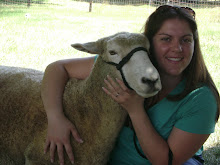Sheep are docked to prevent something called fly strike. Fly strike happens when wooly tails are left on the sheep, which sometimes causes manure to build up on the tail. Flies find this an attractive environment for laying eggs, and soon maggots start eating the sheep, leading to fly strike. Other countries don't dock and don't have issues, but it's generally accepted practice to dock tails here in the US.
I dock using the banding method, which creates an open wound. I like to give a tetanus antitoxin vaccine at docking to make sure the lambs are protected against tetanus. They're covered by passive immunity from their mother (who got the CD/T shot before lambing), but I really want to be safe. Some people skip the antitoxin shot, and that's ok too. This is just how I do it.
I could only find single dose vials of the antitoxin at the feed store yesterday, so I grabbed two of them. This can be given IM (intramuscularly) or sub-q (subcutaneously).

Next come the tools. This is a rubber band that is used with docking and castrating. The band is placed around the tail or testicles, and cuts off the circulation which kills the tissue. Eventually the tail/testicles will dry out and fall off.

This is called an Elastrator. This tool spreads the rubber band so you can place it around the tail or testicles.

The band gets placed around the 4 prongs of the Elastrator, and when you squeeze the handles, the band opens.

There is much controversy over the proper place to dock. People who own show animals prefer to dock as close to the body as possible, some even going so far as to have the tail surgically removed. I used to show, but never really was a fan of the ultra-short docking. Some believe this close docking (for purely cosmetic reasons) leads to rectal prolapse (exactly what it sounds like) in sheep. Show people argue that prolapses are caused over genetics and feeding, not docking. I disagree. I think improper feeding and genetics may also lead to rectal prolapses, but I think sheep evolved with tails and removing too much of the tail alters the skeletal and muscular structure of the sheep making it more prone to prolapse. Ok, enough controversy. A generally more accepted location for docking is at the distal end of the caudal tail fold. What does that mean, you ask?
Well, on the underside of the tail (head being cranial end of body, tail being caudal end) there's a webbing of skin (or "fold")on either side. The end of the fold that is farthest away from the body (distal) is the best* place to place the band. The caudal fold helps direct feces away from the body, so it's helpful to leave it intact.

Now it's time to place the band on the tail. I was working solo today, so I used the self-timer on the camera to help me get the shot. David works later than I do, so I could have waited for him to get home, but then my lighting for pictures would have been gone.
If I'm by myself, I hold the lamb between my knees so he/she can't go anywhere. The band gets slid up the tail into the correct position.

I usually double check and sometimes triple check to make sure I have the band in an ok location before I let it close. Once I let the band close, I use one hand to slide the band off the prongs.

Here you can see the band is placed at the distal end of the fold.

This method of docking does cause some pain, as does any method I think. The lambs generally act a little wonky (some throwing themselves on the ground, getting up and down, etc) for about 10 or 15 minutes, but after that I think the tail starts to get numb. They get a nurse from mom and then they seem fine.
The tail usually is totally numb by the next day. Some people prefer to cut the tail off a day or two after banding, but I just leave it on. I make sure to check for any signs of infection, and treat if needed. Tails usually fall off in a few weeks. Testicles don't usually take as long, since the scrotum is just soft tissue.
Oh, and I've decided to name the ewe lamb Poppy! And check out her reach here. See the tan spot on her hind leg? Cute!

*In my opinion.


7 comments:
Yay for Poppy having a name! Cute name! :) I love her reach. LOL Did you castrate the ram lamb? Impressive use of the self-timer :)
No, I haven't castrated him yet. I'm going to wait a little longer I think.
Ouch... :)
You are a true farmer! One of the reasons I haven't succumbed to sheep yet is precisely this task. I appreciate the tutorial.
Wow, I am amazed at all you know about your animals Katie! You are something else hon! Love, Momma
my words almost exactly except just a tad longer its like there is a bigger vertabrae there saying "right here". Of cource leaving the bigger vertabrae on the lamb.
Wow, and I heard on a place about raising, and such about goats, banding was horrible. That it was extremely painful. I understand if banding the scrotum is painful, but on a sheep, it sounds fine. Great to learn considering I'm getting 2 lambs in a week or so !! :D
Cute name!
Post a Comment